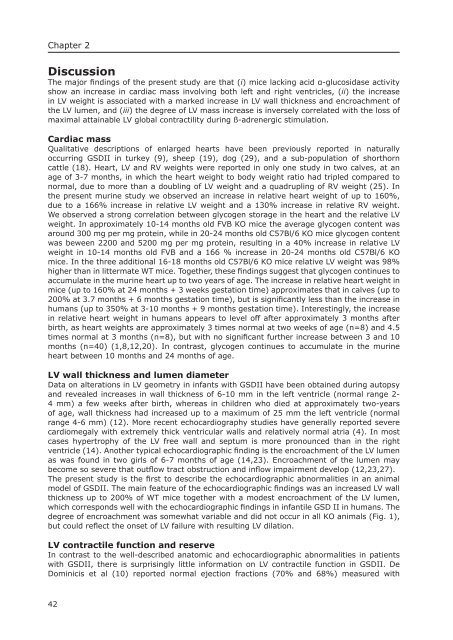Pompe's disease - RePub - Erasmus Universiteit Rotterdam
Pompe's disease - RePub - Erasmus Universiteit Rotterdam
Pompe's disease - RePub - Erasmus Universiteit Rotterdam
You also want an ePaper? Increase the reach of your titles
YUMPU automatically turns print PDFs into web optimized ePapers that Google loves.
Chapter 2<br />
Discussion<br />
The major fi ndings of the present study are that (i) mice lacking acid α-glucosidase activity<br />
show an increase in cardiac mass involving both left and right ventricles, (ii) the increase<br />
in LV weight is associated with a marked increase in LV wall thickness and encroachment of<br />
the LV lumen, and (iii) the degree of LV mass increase is inversely correlated with the loss of<br />
maximal attainable LV global contractility during ß-adrenergic stimulation.<br />
Cardiac mass<br />
Qualitative descriptions of enlarged hearts have been previously reported in naturally<br />
occurring GSDII in turkey (9), sheep (19), dog (29), and a sub-population of shorthorn<br />
cattle (18). Heart, LV and RV weights were reported in only one study in two calves, at an<br />
age of 3-7 months, in which the heart weight to body weight ratio had tripled compared to<br />
normal, due to more than a doubling of LV weight and a quadrupling of RV weight (25). In<br />
the present murine study we observed an increase in relative heart weight of up to 160%,<br />
due to a 166% increase in relative LV weight and a 130% increase in relative RV weight.<br />
We observed a strong correlation between glycogen storage in the heart and the relative LV<br />
weight. In approximately 10-14 months old FVB KO mice the average glycogen content was<br />
around 300 mg per mg protein, while in 20-24 months old C57Bl/6 KO mice glycogen content<br />
was beween 2200 and 5200 mg per mg protein, resulting in a 40% increase in relative LV<br />
weight in 10-14 months old FVB and a 166 % increase in 20-24 months old C57Bl/6 KO<br />
mice. In the three additional 16-18 months old C57Bl/6 KO mice relative LV weight was 98%<br />
higher than in littermate WT mice. Together, these fi ndings suggest that glycogen continues to<br />
accumulate in the murine heart up to two years of age. The increase in relative heart weight in<br />
mice (up to 160% at 24 months + 3 weeks gestation time) approximates that in calves (up to<br />
200% at 3.7 months + 6 months gestation time), but is signifi cantly less than the increase in<br />
humans (up to 350% at 3-10 months + 9 months gestation time). Interestingly, the increase<br />
in relative heart weight in humans appears to level off after approximately 3 months after<br />
birth, as heart weights are approximately 3 times normal at two weeks of age (n=8) and 4.5<br />
times normal at 3 months (n=8), but with no signifi cant further increase between 3 and 10<br />
months (n=40) (1,8,12,20). In contrast, glycogen continues to accumulate in the murine<br />
heart between 10 months and 24 months of age.<br />
LV wall thickness and lumen diameter<br />
Data on alterations in LV geometry in infants with GSDII have been obtained during autopsy<br />
and revealed increases in wall thickness of 6-10 mm in the left ventricle (normal range 2-<br />
4 mm) a few weeks after birth, whereas in children who died at approximately two-years<br />
of age, wall thickness had increased up to a maximum of 25 mm the left ventricle (normal<br />
range 4-6 mm) (12). More recent echocardiography studies have generally reported severe<br />
cardiomegaly with extremely thick ventricular walls and relatively normal atria (4). In most<br />
cases hypertrophy of the LV free wall and septum is more pronounced than in the right<br />
ventricle (14). Another typical echocardiographic fi nding is the encroachment of the LV lumen<br />
as was found in two girls of 6-7 months of age (14,23). Encroachment of the lumen may<br />
become so severe that outfl ow tract obstruction and infl ow impairment develop (12,23,27).<br />
The present study is the fi rst to describe the echocardiographic abnormalities in an animal<br />
model of GSDII. The main feature of the echocardiographic fi ndings was an increased LV wall<br />
thickness up to 200% of WT mice together with a modest encroachment of the LV lumen,<br />
which corresponds well with the echocardiographic fi ndings in infantile GSD II in humans. The<br />
degree of encroachment was somewhat variable and did not occur in all KO animals (Fig. 1),<br />
but could refl ect the onset of LV failure with resulting LV dilation.<br />
LV contractile function and reserve<br />
In contrast to the well-described anatomic and echocardiographic abnormalities in patients<br />
with GSDII, there is surprisingly little information on LV contractile function in GSDII. De<br />
Dominicis et al (10) reported normal ejection fractions (70% and 68%) measured with<br />
42

















